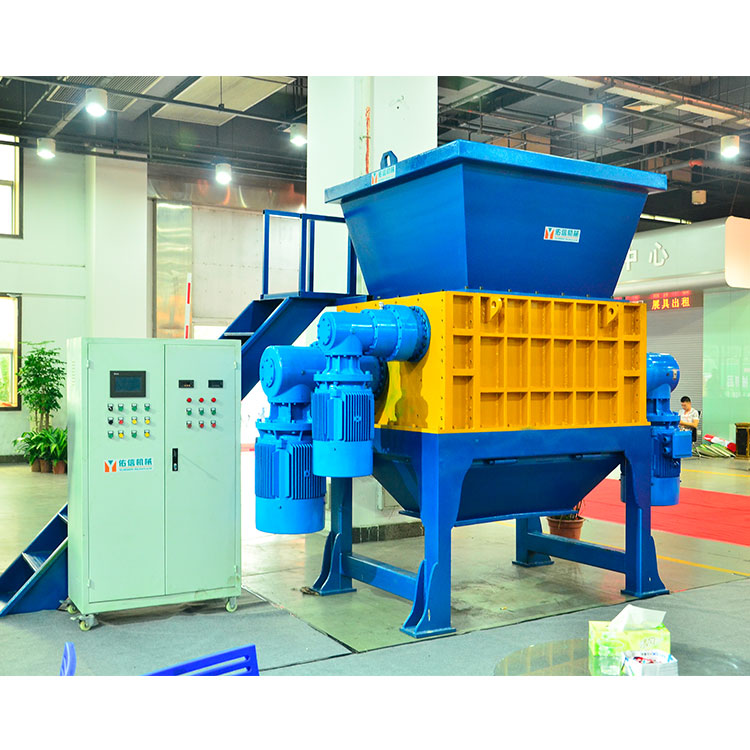Understanding the Plastic Shredder
2025-02-14
A plastic shredder is a machine designed to reduce plastic materials into smaller, manageable pieces. It is a crucial part of the recycling process, helping to break down plastic waste for recycling, repurposing, or disposal. The shredded plastic can be used in various industries for manufacturing new products, thus contributing to a more sustainable and circular economy. In this article, we will explore what a plastic shredder is, how it works, and its applications.
What is a Plastic Shredder?
A plastic shredder is an industrial machine used to cut, break, or shred large pieces of plastic into smaller fragments. The machine is designed to handle a wide variety of plastic waste, including bottles, containers, packaging, and even plastic components from discarded electronic devices. Shredding the plastic makes it easier to process and recycle, turning it into reusable raw material.
Plastic shredders are commonly used in recycling facilities, manufacturing plants, and waste management industries. They come in different sizes and configurations, depending on the scale of the operation and the type of plastic being shredded.
How Does a Plastic Shredder Work?
The operation of a plastic shredder involves several key components that work together to break down large plastic items into smaller pieces. Here's a basic overview of how it works:
1. Feeding the Plastic: Large plastic items are fed into the shredder either manually or through a conveyor system. The size and type of plastic can vary, and the shredder is designed to accommodate various forms of plastic waste.
2. Rotating Blades: Inside the shredder are rotating blades or knives that are positioned in a way that allows them to cut and tear the plastic. These blades are made of hardened steel and can be adjusted depending on the desired size of the output pieces.
3. Shredding Process: As the plastic enters the shredding chamber, the rotating blades pull the material in, cutting it into smaller pieces. The size of the cut pieces depends on the blade configuration, speed, and the type of material being processed.
4. Discharge: After the plastic has been shredded into small pieces, the material is discharged from the shredder either manually or by an automated system. These shredded pieces can be further processed, melted down, or reused in the creation of new plastic products.
Types of Plastic Shredders
Plastic shredders are available in various configurations to suit different needs. The two main types of plastic shredders are:
1. Single-Shaft Shredders: These shredders are designed with a single shaft that holds several blades. The plastic is fed into the machine, and the shaft rotates to break down the material. Single-shaft shredders are often used for handling larger, more rigid plastic materials.
2. Two-Shaft Shredders: As the name suggests, these shredders feature two opposing shafts with interlocking blades. The dual shafts rotate in opposite directions, effectively tearing apart the plastic material. These shredders are more effective for handling a wider range of plastic types and offer more versatility.
3. Four-Shaft Shredders: These are heavy-duty machines with four rotating shafts and are used for processing larger volumes of plastic or tougher materials. Four-shaft shredders are ideal for industrial-scale recycling operations and can handle a variety of waste materials.
4. Granulators: Granulators are specialized machines used to further process the shredded plastic into smaller granules or pellets. These granules can be used as raw material for creating new plastic products.
Benefits of Using a Plastic Shredder
1. Waste Reduction: One of the primary benefits of using a plastic shredder is the reduction of waste. Shredding plastic waste makes it easier to store, transport, and recycle, which ultimately helps to reduce the amount of plastic that ends up in landfills or pollutes the environment.
2. Recycling Efficiency: By shredding plastic, recycling facilities can process materials more efficiently. The shredded plastic is easier to handle and can be reused to create new products, reducing the need for virgin plastic and conserving resources.
3. Cost-Effective: Shredders can be used to recycle a wide variety of plastic materials, including bottles, bags, and packaging. This allows manufacturers to create new products from recycled plastic at a lower cost than producing them from raw materials.
4. Environmental Impact: The recycling of plastic reduces the demand for new plastic production, which can help decrease the environmental impact of plastic manufacturing. By using a plastic shredder, companies contribute to a more sustainable and circular economy.
5. Space Saving: Shredded plastic takes up much less space than whole plastic items, making it easier to store and transport. This is particularly important for businesses that generate large volumes of plastic waste.
Applications of Plastic Shredders
Plastic shredders are used in various industries for different purposes, some of which include:
1. Recycling: Plastic shredders are widely used in recycling plants to process plastic waste. The shredded plastic can be sold as raw material for the production of new plastic items, reducing the need for virgin plastic.
2. Plastic Manufacturing: In manufacturing, shredded plastic can be used as an input material for making new plastic products. This is especially common in the production of plastic parts, such as automotive components or packaging materials.
3. Waste Management: Plastic shredders are used in waste management facilities to process plastic waste and reduce the volume of material that needs to be disposed of. This helps to manage waste more efficiently and supports recycling efforts.
4. Electronic Waste Recycling: Many electronic devices contain plastic parts that can be recycled. Shredders are used to break down the plastic components of e-waste, which can then be processed for reuse.
5. Agricultural Applications: Plastic materials used in agriculture, such as plastic films or netting, can be shredded and recycled into new products. Shredders are used to process these materials and reduce waste in the agricultural sector.
Conclusion
Plastic shredders play a crucial role in the recycling and waste management industries by breaking down plastic waste into smaller, manageable pieces. This allows for the efficient recycling of plastic materials, reducing waste, conserving resources, and minimizing the environmental impact of plastic production. With various types of shredders available, from single-shaft to four-shaft designs, these machines are versatile and can be used in many industries. As global concerns about plastic waste continue to grow, the use of plastic shredders will remain an important part of efforts to create a more sustainable and circular economy.



